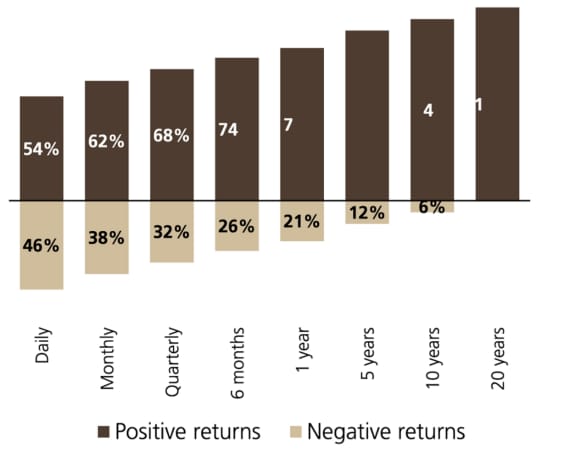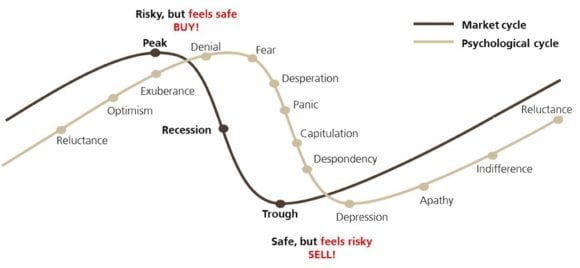Behavioral finance and COVID-19
Discover the strategies investors can use to overcome behavioral biases in periods of market volatility.
At a glance
At a glance
Investing is about meeting financial goals, and it's natural, that investing is often an emotional experience, especially during periods of heightened market volatility. After all, when your portfolio is at risk, it puts your goals—and thus the well-being of those you care about—at risk.
The COVID-19 pandemic has been a particularly stressful experience, combining significant financial uncertainty— including the fastest-ever bear market sell-off, and the sharpest bout of job losses in history—with a global public health crisis and significant social unrest.
In the summary below, we investigate how stress hampers our decision-making faculties and our ability to invest rationally. We also explore some strategies that investors can use to overcome behavioral biases to survive —and even prosper—in periods of market volatility.
Strategies to overcome behavioral biases
Strategies to overcome behavioral biases
We discuss some strategies that you can use to keep your instinctual impulses at bay. The process begins by building an investment strategy and adopting investment habits that can provide investors with the emotional comfort and confidence to stay the course during periods of volatility.
Strategy 1: Diversify
At its heart, diversification is about reducing the role of luck in investment success. Without diversification, an investment strategy has risk that is concentrated in one area, which means that it is fragile.
Diversification works by introducing variety to dampen different types of risk: Individual company risk can be diversified by holding a basket of stocks; industry risk can be mitigated by spreading stock investments across multiple sectors; stock market risk can be reduced by holding uncorrelated asset classes such as high-quality bonds.
A diversified portfolio is composed of assets whose prices move out of sync with each other, such that extreme returns in one asset class are tempered by modest returns in other asset classes. The net effect of this interaction is a reduction in risk per unit of return, which means that diversification is therefore a very useful tool that can help investors achieve a greater potential rate of return while enjoying a smoother path of growth, and thus a more comfortable investment experience.
Strategy 2: Reduce the noise
It's understandable that, when a crisis happens, investors spend many hours reading or watching the news to stay informed and updated. Investors also naturally pay more attention to markets when volatility is high.
This impulse to pay closer attention can be counterproductive to making good decisions. Although we live in an age of nearly infinite access to information, meaning and context have grown more difficult to find. Watching more news doesn't give you more context. In addition to focusing on negative aspects, the news also promotes a sense of urgency that can play into our anxieties. Because we suffer from behavioral biases like "recency bias" and "saliency bias," we tend to overreact to news that's recent, prominent, or easily accessible—and due to "confirmation bias," this can create a feedback loop where we focus on information that supports our preconceptions.
By contrast, looking at the news less frequently helps to reduce the noise. It's also incredibly valuable to have a financial advisor who can help to filter the information, putting it into the context of your portfolio and your financial plan. Advisors thus serve as a last line of defense to protect against the impulse to make changes in reaction to short-term market events, helping you to focus your attention on the information and decisions that matter. Last, but not least, it's important to reduce the number of decisions that you have to make during periods of stress.
Frequency of losses, S&P 500 returns since 1926 by holding period
Strategy 3: Understanding risk, and your risk tolerance
It's important for you to understand the risks of your investments. In finance, we have several statistics to measure an investment's risk—drawdown, variance, beta, etc. None of these are intuitive concepts, but they are relatively easy to learn with the help of your financial advisor. More importantly, your advisor can help you calibrate your expectations so that you're emotionally ready when extreme market movements occur. But while it's important for us to learn from our mistakes, experience often teaches lessons that come too late to be useful. To anticipate and prepare for new types of risk, we need to run a simulation.
One strategy is to walk through a "pre-mortem" with your advisor. Pre-mortems are a thought exercise where you assume an outcome and then work backwards to arrive at possible causes. One benefit of this approach is that it can uncover risks that we would normally overlook.
Another approach is to go through a "fire drill" exercise with your financial advisor. To help with this process, we developed a Bear market calculator to help you simulate a worst-case market scenario and evaluate how this would affect your financial success. Running through this simulation can also help you assess whether you will be comfortable sticking with your investment strategy in times of extreme volatility and uncertainty.
Recency bias can lead us to chase performance
Strategy 4: Align your portfolio with your goals
Before making any decisions about the right investment strategy for your hard-earned savings, it's always important to have a deep conversation about what matters to you and your family: What do you want to accomplish in your life? What are your main concerns? How do you plan to achieve your life's vision? These aren't easy questions, but the answers are key to uncovering the objectives and priorities that will comprise your financial plan. The next step is to take these principles and goals and map them onto an investment strategy using the Liquidity. Longevity. Legacy* (3L) framework.
The 3L framework helps you develop a personalized investment approach by segmenting your family's total wealth into three strategies: a Liquidity strategy, designed to meet your family's cash flow needs for the next two to five years; a Longevity strategy, consisting of the resources needed for spending throughout retirement and the rest of your lifetime; and a Legacy strategy that is earmarked for growth to benefit future generations and philanthropic organizations.
Part of the value of segmenting your wealth by purpose and time-frame is to provide perspective during periods of uncertainty. When you view all of your investments as a single portfolio, it can be very difficult to gain perspective. Segmenting your assets can help to put market returns into context and give you a more objective lens for making decisions.
The Liquidity. Longevity. Legacy. (3L) framework
Recommended reading
Recommended reading







